
Steamboat Photos, page 5
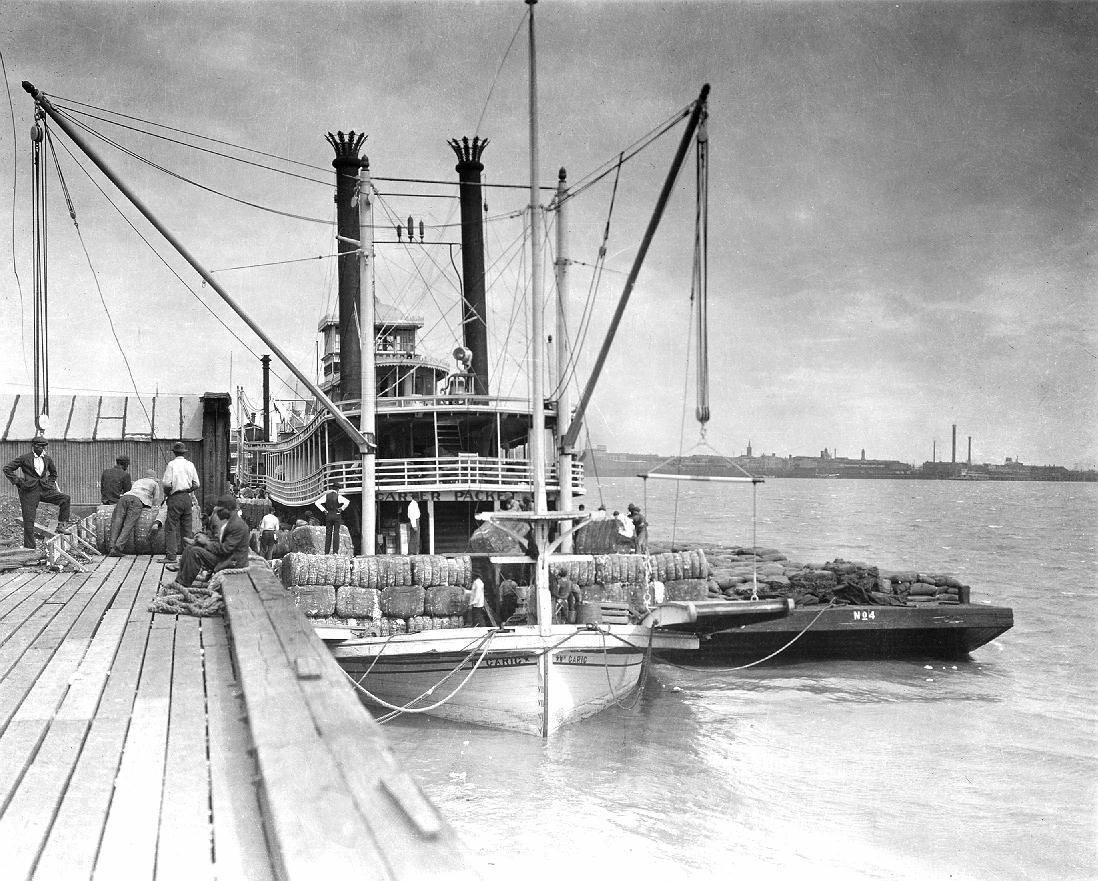
Cotton packet! Latest acquisition . . . Wm. Garig of the Carter Packet Co. Double stamped original 8 X 10 March 21, 1928 photographs from Chas. L. Franck, 400 Baronne Street, New Orleans, LA.
Jim Hale's comment on the Wm. Garig photo:
I HAVE TO AGREE WITH CAPT. FRED WAY, THE BEST LOOKING OF THE LATER DAY COTTON PACKETS WERE, THE AMERICA, THE BOB BLANKS AND THE WM.GARIG. THIS SAME PICTURE IS IN "TALES OF THE MISSISSIPPI", ON PAGE 114.
I HAVE OFTEN LOOKED AT IT AND NOW I HAVE A COPY OF THE ORIGINAL WITH LOTS OF DETAIL TO LOOK AT.
THIS PICTURE MUST HAVE BEEN TAKEN AFTER SHE HAD AGED A BIT BECAUSE THE FANCY RAILING IS GONE AND REPLACED WITH TOW BOAT RAILING.
THIS IS THE BEST PICTURE YOU HAVE GOTTEN IN A LONG TIME.
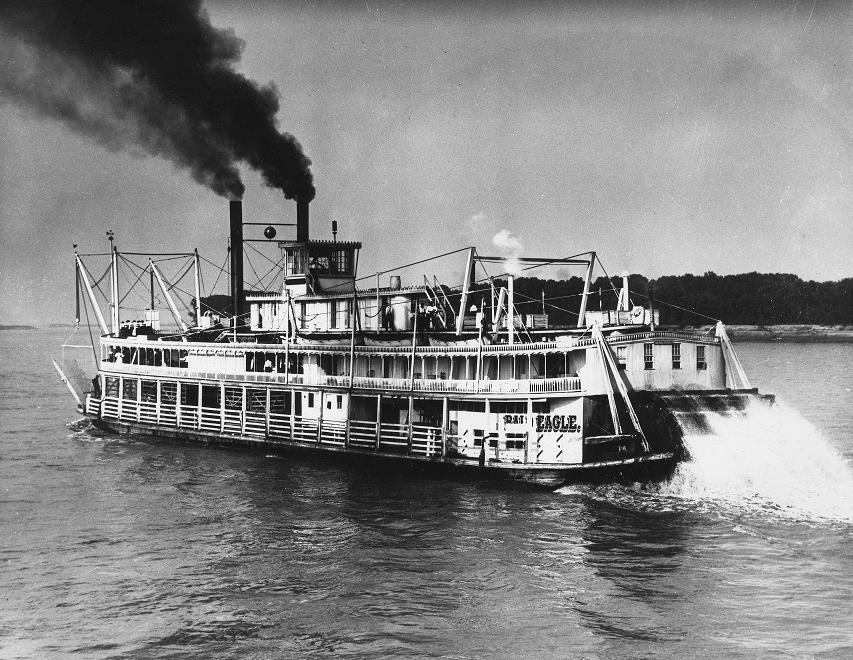
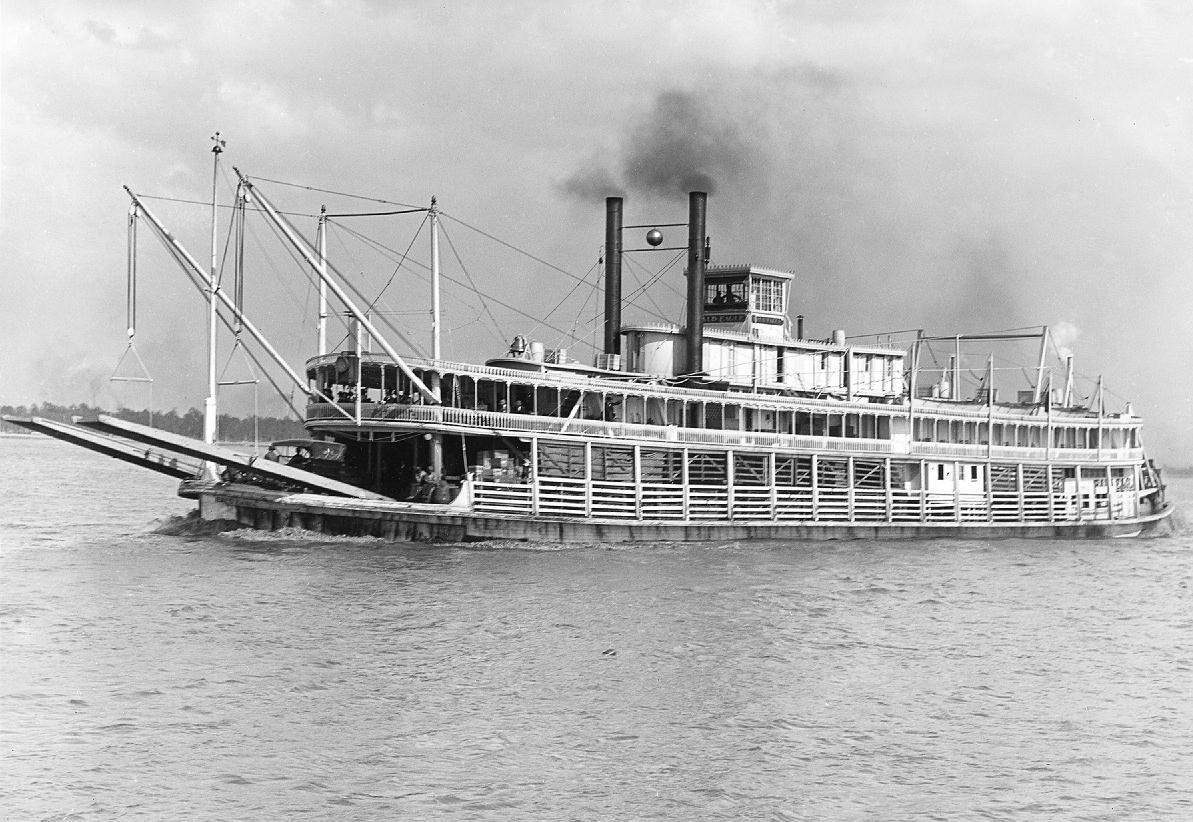
Two photos of the Bald Eagle (above).
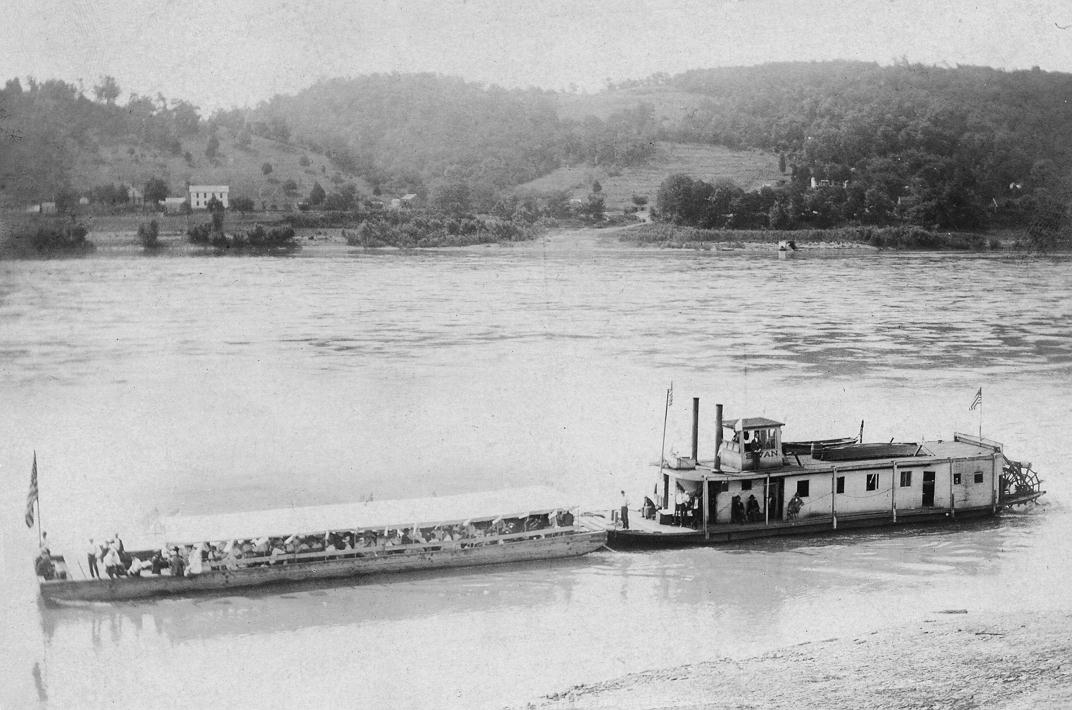
Most modest excursion boat I've ever seen, the little SWAN pushing a wooden barge with passengers, maybe off to a picnic along the shore or on an island somewhere. Postmarked Rising Sun, Indiana - looks like 1908. Right across the Ohio River in Kentucky is the memorably named village of Rabbit Hash.
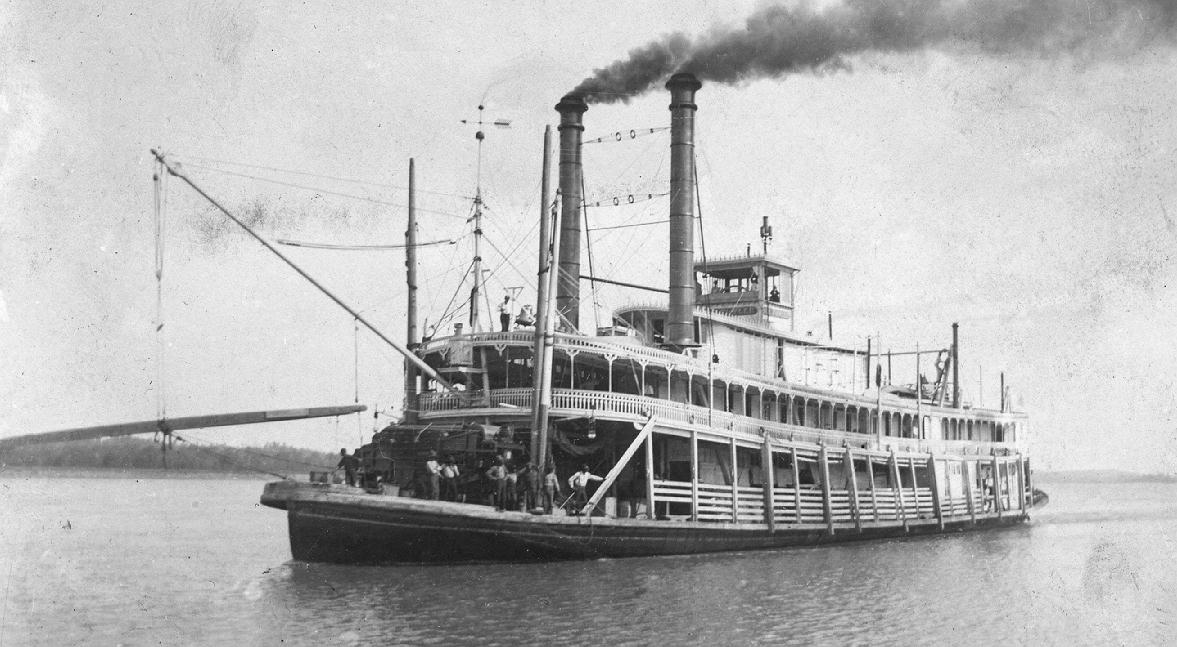
Here's the old original JOE FOWLER (1888 to circa 1917) on a RPPC.
I imagine both Walt Disney and his aide-de-camp Joe Fowler were likely aware that an actual steamboat bore his name in ye olden days.
In Florida's Disney World the clone of Disneyland's MARK TWAIN launched in 1971 bore the name ADMIRAL JOE FOWLER which lasted until 1980 when its hull was destroyed while the boat was being lifted out of the water with a crane.
Joe Fowler was an attraction designer for the theme parks and actually was a retired U.S. Naval Admiral, hence the name of the boat.
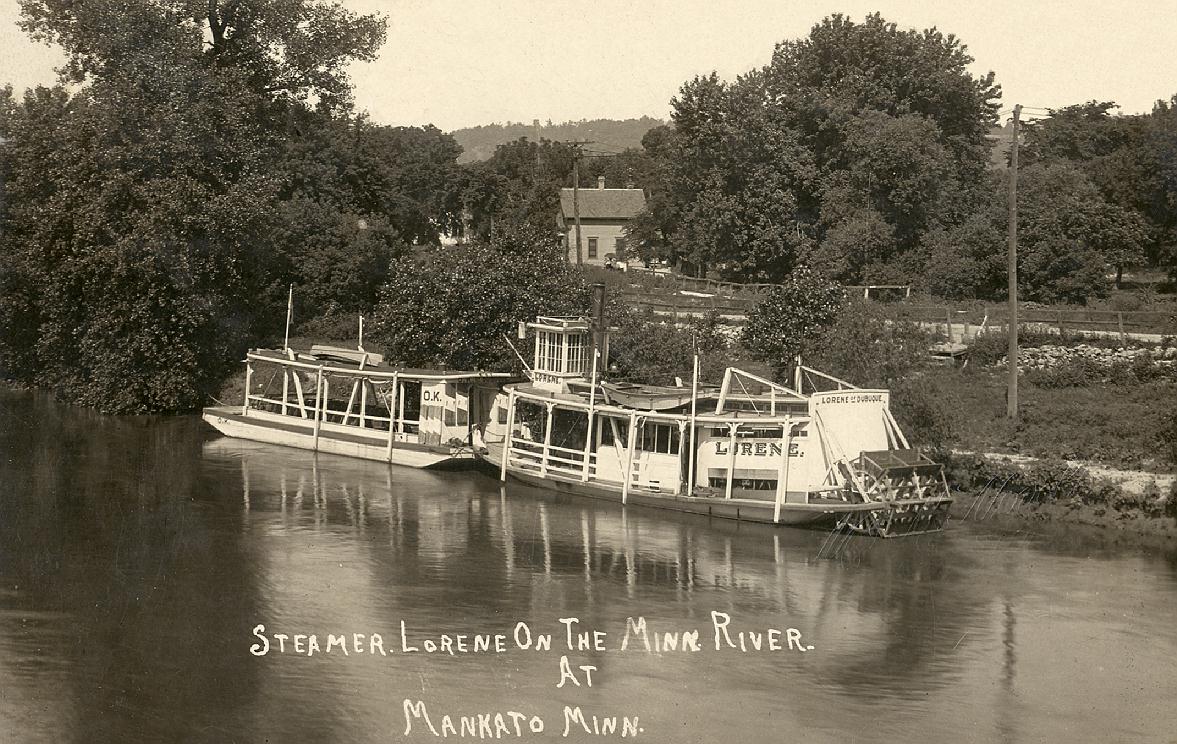
Per Fred Way's Packet Directory this little steamboat was:
LORENE built Dubuque 1905. 48.8 x 11.5 x 2.4.
Made trips to "the Dales of St. Croix".
Burned at Ft Snelling 23, Nov, 1911.
Here she's at Mankato on the Minnesota pushing an excursion barge called O.K. but she also made excursions on the Upper Mississippi.
Postmarked MINNEAPOLIS & CO. BLUFFS R.P.O. AUG 8, 1909.
This is a detail of the card where the boat and barge only take up about half of the width of the card at center.
The embossed name M & K Novelty STUDIO, MANKATO is not visible to the naked eye except at an angle but the scanner picked it up. Retouching doesn't seem to help since there's still a ghost of the lettering left behind no matter what I attempt in Photoshop.
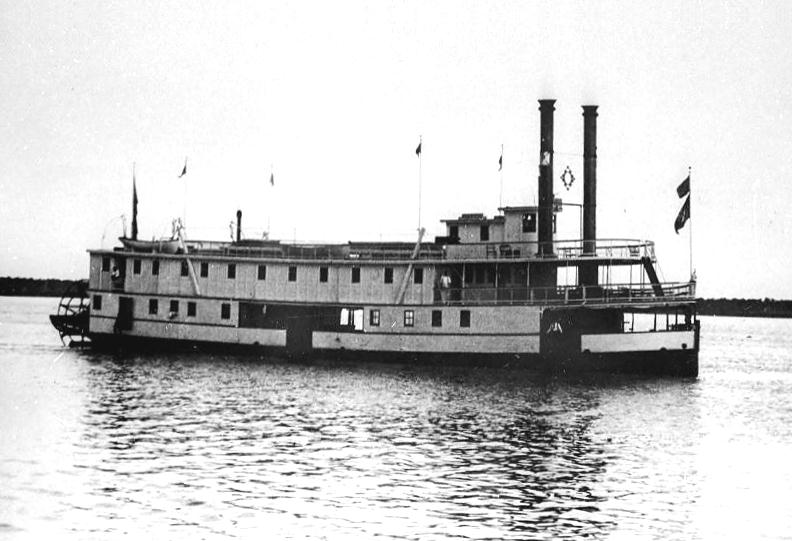
Lewis Verduyn of Steamboat Times in New Zealand found these online for me . . . A photo of the St. Lucie from a distance (I sent you one of her with 10 passengers) and and a news article from 2006 that my Google search didn't turn up. If you decide to do a feature on St. Lucie with pictures include credit and links below:
Photo is from University of South Florida website, usf.edu.
The following 1906 report on the St. Lucie's destruction, comes from The Miami News - Jul 2, 1983 where the 1906 article was edited and reprinted (see original - click here):
The Miami Daily Metropolis, Oct. 20, 1906
STEAMER ST. LUCIE WENT DOWN
NEAR MOUTH OF CAESARS CREEK;
TWENTY-FIVE WERE DROWNED
Had Aboard One Hundred
and Fifteen Persons
Mostly Extension Laborers
Thursday's hurricane will go on record as the most disastrous in point of casualties that ever visited this or any other section of Florida. Conservative estimates now place the number of dead at more than one hundred and possibly one hundred and fifty, though details and data are coming in as rapidly as possible...
All of the losses so far ascertained are in the keys and among the extension employees. The greatest loss of life and property was at Long Key where every craft was either sunk and driven to sea with large numbers of men aboard, and in the sinking of the steamer St. Lucie off Elliott's Key, twenty-five or more men being drowned from the vessel . . .
The beach at Elliott's Key is strewn with corpses and debris. The area of wreckage extends half a mile inland. It is a scene of destruction. At Long Key the conditions are practically the same, except that but few, if any, bodies are on the shore.
Grave apprehension for safety of the steamer prevailed all day yesterday. There was a ray of hope, however. but this was shattered upon the arrival of the steamer Peerless, at the terminal dock at 6 o'clock last evening with the majority of the survivors of the Ill-fated craft aboard and the news of the fearful casualty.
Immediately the news spread and hundreds flocked to the dock, the majority out of idle curiosity. Men that had been strong and nervy, hobbled ashore, all more or less injured but none fatally. Some were too weak to walk and had to be assisted.
Various stories and reports were in circulation relative to the disaster of the St. Lucie and they soon became voiced about the city . . .
One of the most complete and graphic stories of the catastrophe and the scenes attending the wrecking of the steamer is told by Second Officer J.W. Grant, one of the survivors. Mr. Grant said:
"We left Miami late Wednesday evening about 7 o'clock, I think. We had aboard 115 extension laborers, the greater portion of them white with five or six negro women and one white woman and child. We also had a water barge in tow. All went well until we were off Elliott's Key. About daylight Thursday morning the wind came out of the northeast and we headed to it, putting out two 500 pound anchors. These held but a short time when they parted. Another anchor weighing 400 pounds, held by a large Manila cable was put out and it held, but the wind and sea rose so high that we cut loose both anchors and barge and went adrift. Great seas boarded the boat and all hands rushed to the hurricane deck. She would not steer and about 8 o'clock capsized and went down in about fifteen feet of water, two miles off Elliott's Key and three miles from Caesar's Creek. Not a person had been lost to that time.
"A little later there was a lull and during this ten men and myself manned three life boats and started for a two masted coasting schooner that lay between us and the land. Our intention was to take it and go to the rescue of the people huddled on the upper deck of the St. Lucie. We made the schooner, no one was on board it . . .
All of the men but myself and a companion boarded the craft and started to sail it to the St. Lucie. They had gotten well under way and were close to the steamer when the wind came out of the north and west, and they were driven away and off their course. The sea, which had abated some, picked up again.
Great God, I have never seen it so high. The rain was blinding and beat our faces like shot. I could see nothing more until a sea pitched us out of the lifeboat and into the mangroves on the shore. There my companion and myself clung in the top branches.
"Through the fog like rain I saw the schooner being driven down upon us. She was coming broadside and I prepared to cash in. The water was over the top of the mangroves and flooded the whole key six feet deep. Over the bush the vessel passed, coming so close that my companion managed to swing onto her and was carried inland. Today she is a quarter of a mile on the interior of the island, high and dry.
"I hung onto the bush and as the tide receded I climbed down and was finally able to touch ground. Later on I was able to crawl and finally reached the interior of the island. I know not just what happened on the St. Lucie after the wind came out of the northwest except that the hurricane deck went by and all were thrown into the water. While I hung onto the bush, men came ashore, some were dead and some were not. They drifted between all kinds of debris and all landed either in the mangroves or went over them into the interior of the island. Those that were able clung to the branches and in this way the most of them were saved. Those that were dead lodged in the trees In most cases, though some passed over them, so high was the water...
The tide receded rapidly. It had been a regular tidal wave with seas rolling ten and twelve feet high. After the survivors could get a foothold on the land, we had the time and mind to survey the calamity. Dead bodies were everywhere and men groaning and suffering with pain, bruises and cuts. We found twenty-five or twenty-six bodies, but I believe there are more beneath the debris on the bank."
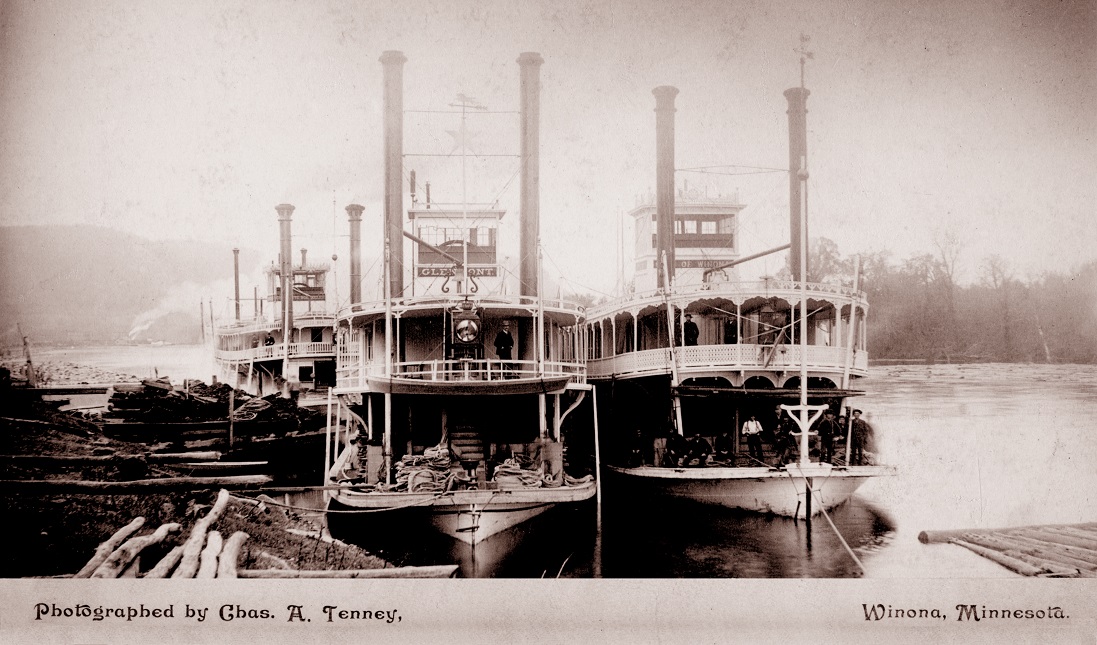
These 3 darling little rafters at Winona, Minnesota on the Mississippi are particularly fetching.
The CHARLOTTE BOECKELER (far left) was built in 1881
the GLENMONT (center) 1885
and the CITY OF WINONA (right) in 1882
Photo was taken circa 1885 or later.
5 X 8 inch albumen print on a card with photographer Charles A. Tenney's stamp.
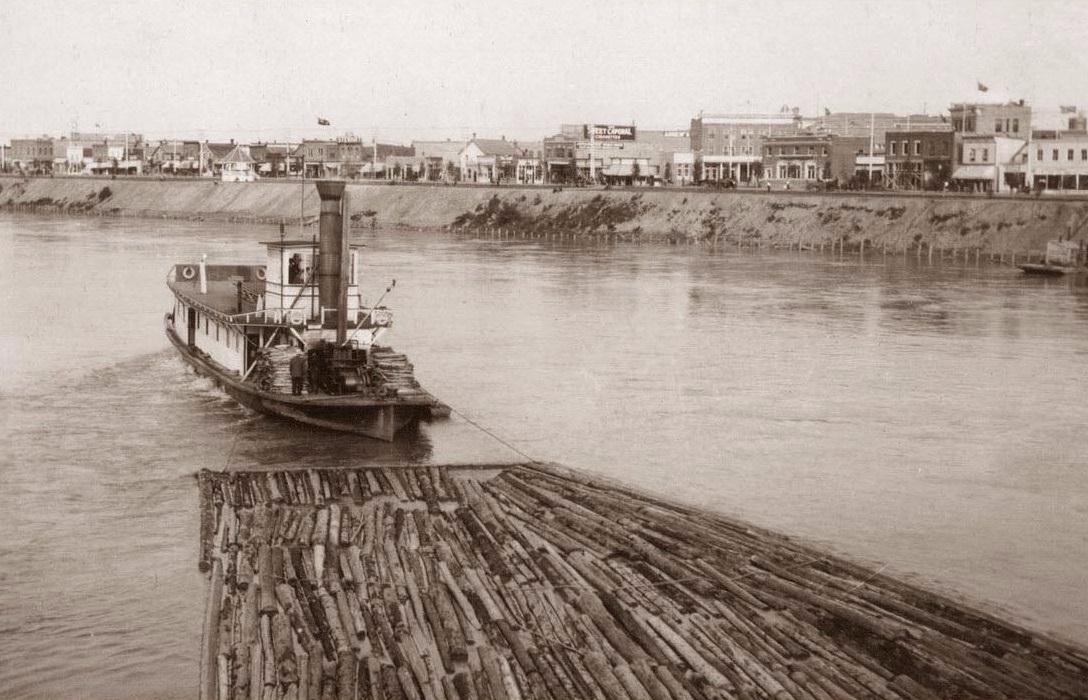
rafting logs on the North Saskatchewan River
Unknown steamer rafting logs on the North Saskatchewan River with the community of Prince Albert, Saskatchewan, Canada in the distance on the south bank of the river.
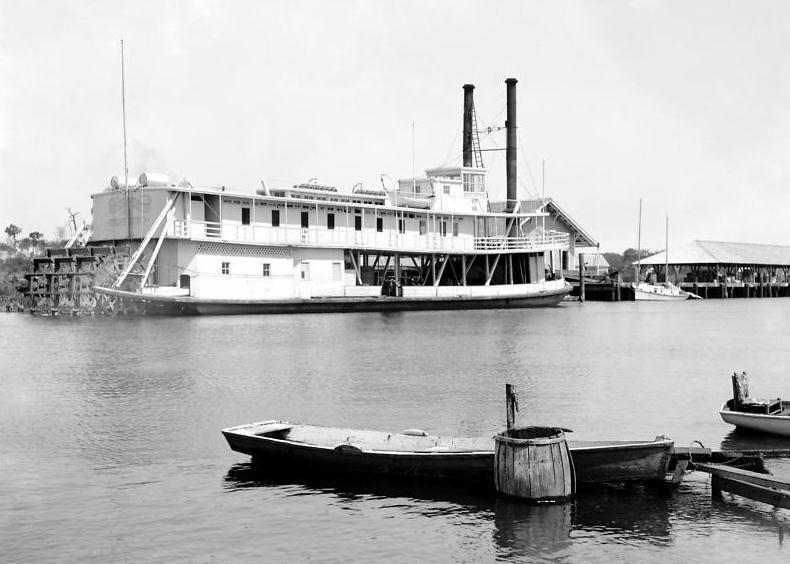
From the Library o' Congress a photo of the BISCAYNE on the Miami River in Florida in 1901. Named for an Island called Key Biscayne just off the Florida coast.
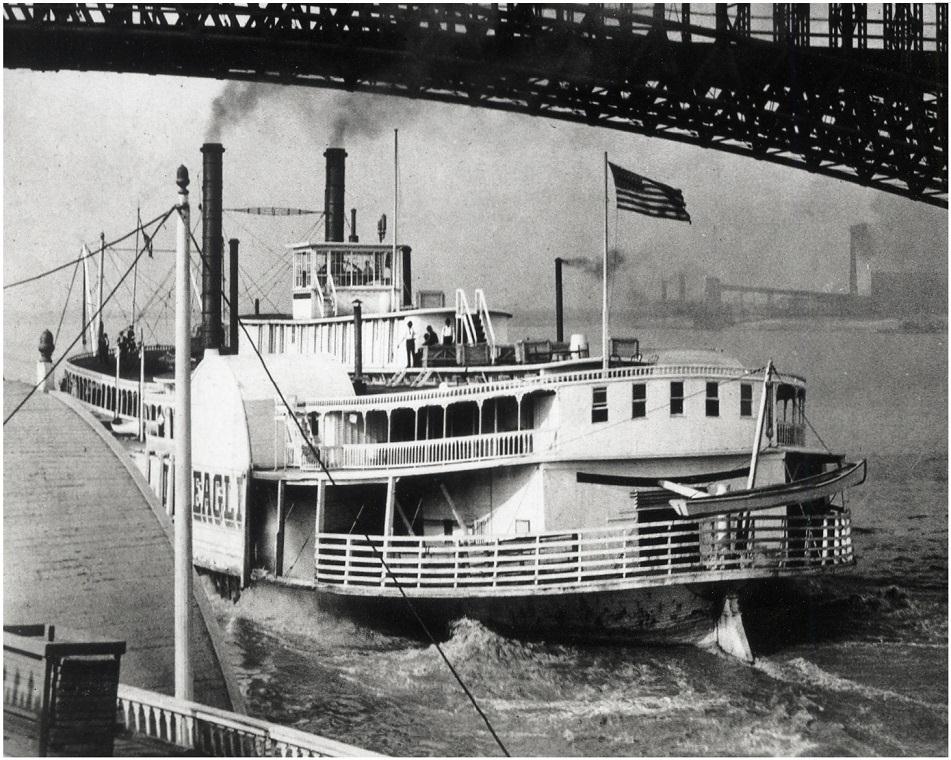
I was given this snapshot along with a bunch of others years ago. The dramatic three quarters stern view of a speedy steamboat about to pass under the Eads Bridge at St. Louis was taken from the hurricane roof of another sidewheeler whose paddle box is prominent in the lower left quadrant.
Had assumed for a long time that this was one of a number of boats that had "EAGLE" as their last name. The boat that most closely resembles this boat in the Murphy Library site is the second steamer called SPREAD EAGLE (1897-1910). The Murphy photo Number 35415 of that SPREAD EAGLE was taken from a similar angle but a lower vantage point. While there are many similarities between the two boats there are also significant differences which suggests they are not one and the same.
Some of the bulkhead may have been missing just aft of the paddlebox which could explain why the horizontal portion of the "L" in EAGLE is missing and the last "E" is gone. However if the boat's last name ended with the letter "I", making the last portion of the word "EAGLI" then it suggests it had another name entirely, a mystery yet to be resolved.
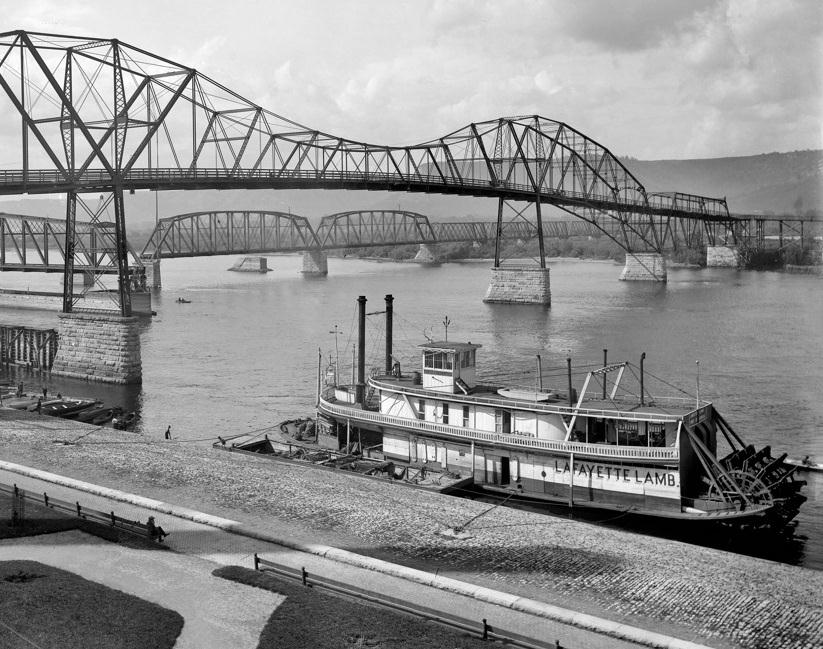
LAFAYETTE LAMB at Winona, Minnesota in 1898
Detail from a Detroit Publishing photograph
Pretty picture taken from a high angle with riverfront park in the foreground
LAFAYETTE LAMB
Sternwheel Rafter
Built 1874 at Clinton, Iowa
Way's Steam Towboat Directory Number T1541
Owners:
C. Lamb and Sons; Valley Navigation Company (1893)
Bronson and Folsom Towing and Transportation Company (1899)
Officers:
Lafayette Lamb (master, 1874); Captain Cyrus King (master, 1883); Captain John Monroe (master, 1890); Captain J.E. Kaiser (master, 1893) Captain Stephan B. Hanks (pilot/master, 1878); Chris C. Carpenter (pilot, 1899)
Was the first boat of the season to arrive at St. Louis from the south on April 2, 1892. Was sold to the Bronson and Folsom Towing and Transportation Company in 1899 for $2500. She then carried a passenger permit as well as towing. Her machinery, etc. went into the building of the packet FOUNTAIN CITY At one time she had served as the bowboat for the ISAAC STAPLES
Dismantled at Stillwater, Minnesota in the winter of 1904-05

With the exception of images credited to public institutions,
everything on this page is from a private collection.
Please contact Steamboats.com for permission for commercial use.*
All captions provided by Dave Thomson, Steamboats.com primary contributor and historian.
